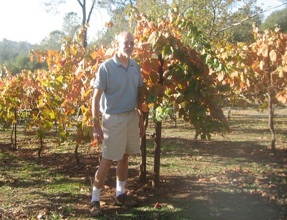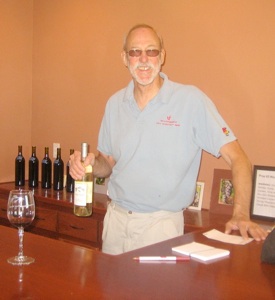Hidden Wineries of Nevada County


Long-time readers of this column might remember a story concerning Guy Lauterbach, from March of 2008, about planting a vineyard. At that time, Guy was in the middle of creating his own two-acre vineyard in Penn Valley and gave us a detailed blow-by-blow account of the process.

Guy Lauterbach is a retired engineer from the computer industry and a self-described life-long wine aficionado. While living in the Bay Area in the 1990s, he purchased acreage in Penn Valley, ultimately moving here in 2001.
Even back then when he was first looking for property, he had thoughts of a vineyard in mind. “I didn’t know anything about it, but I knew I wanted to grow some grapes”, he said at the time.
After relocating, building a house, and settling in, by 2006 it was time to think seriously about the vineyard. He joined the Sierra Wine and Grape Growers to meet people who knew more about the process than he did.
One of the most repeated pieces of advice he heard was the need to have a plan for the grapes. Either know in advance, whom you intend to sell them to, or start planning to turn them into wine yourself. Not having anyone in mind, he decided he best learn how to make wine.
He had decided early in the planning phase to base his vineyard on Cabernet Sauvignon. What to plant is never an easy decision, especially if you don’t know where your grapes are going. “Plant what you like” was most common advice he received. “At least that way you can drink it.”

That is where the dilemma lay. When his vineyard reached full production, it would produce around 400 cases of wine a year. That is where we last left Guy Lauterbach, wondering exactly what to do with the pending arrival of almost 5000 bottles of wine, every year.
As it turns out, he has been busy over the last six years. First, to get his feet on the ground, he started making wine as a home winemaker with purchased grapes while he waited for his vineyard to mature.
But he was also watching our local winery scene. There was a dramatic growth spurt of new local wineries occurring around that time. The number of wineries in the county practically doubled. As he watched others become commercially bonded, he had increasing faith that he too could do it. He decided to go ahead.
First, in order to become bonded you have to have a place to bond so in 2009 he started construction of a winery building. He had already built a wine cave for barrel storage. Now he would have a place to crush, ferment and process his grapes into wine.
He started the bonding process in 2010 but could not get it completed in time for the 2010 harvest. Because grapes have to be crushed in a bonded facility in order to be able to sell them as wine, 2010 was his last year as a home winemaker but by now, he was using his own grapes.
Creating a winery requires satisfying a gauntlet of local, state and federal demands leaving a significant paperwork trail. It took about six months for Guy to wade through the process that he recalls as “mostly a lot of waiting around”.
Gray Pine Vineyard & Winery was bonded in 2011 with that year’s harvest becoming the first commercial vintage. Finally, in 2014 we get to see the results of all his efforts, as the 2011 vintage is now available for tasting and sale.
“It’s been a learning process every step of the way,” Lauterbach explained. “Selecting the varietals, establishing the vineyard, building the cave and the winery, it’s been wonderful. Now it’s time to take it out to see what the community thinks.”

He does have a small tasting room in the winery but so far, it is only open by appointment. You can reach Gray Pine at 530-432-7045 or online at www.graypinewinery.com.
Gray Pine Vineyard & Winery - Where Cab Is King
Wednesday, December 3, 2014





